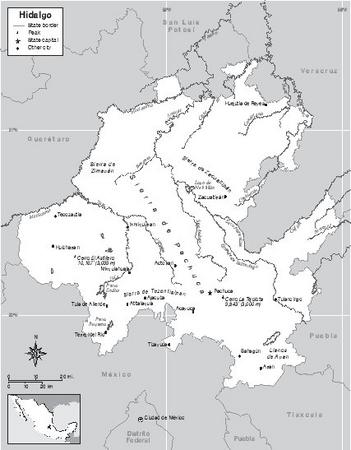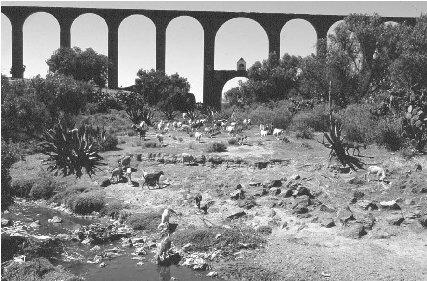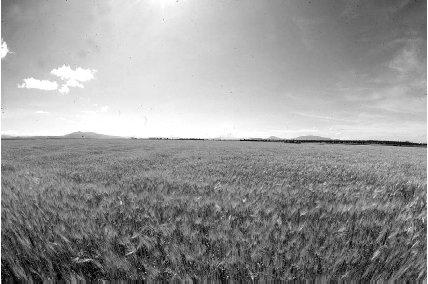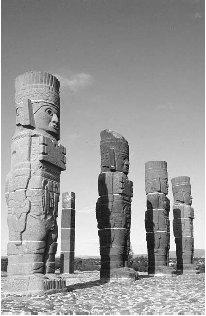Hidalgo

Pronunciation: ee-DAHL-goh.
Origin of state name: Named for the priest, Father Miguel Hidalgo y Costilla (1753–1811), who launched the movement for independence from Spanish rule.
Capital: Pachuca de Soto (often shortened to Pachuca).
Entered country: 1862.
Coat of Arms: The upper half of the seal symbolizes the landscape before the arrival of the Spaniards. The bell on the left represents the call for independence made in 1810. The red cap signifies Hidalgo's status as a free and independent state. The lower half of the seal symbolizes military actions. Flanking the seal on the left is the banner of the Virgin of Guadalupe and on the right is the national flag of Mexico.
Holidays: Año Nuevo (New Year's Day—January 1); Día de la Constitución (Constitution Day—February 5); Benito Juárez's birthday (March 21); Primero de Mayo (Labor Day—May 1); Revolution Day, 1910 (November 20); and Navidad (Christmas—December 25).
Flag: There is no official flag.
Time: 6 AM = noon Greenwich Mean Time (GMT).
1 Location and Size
Hidalgo lies in the center of Mexico. It covers an area of 20,502 square kilometers (7,916 square miles), about the same size as the US state of New Jersey. Hidalgo is bordered on the north by the Mexican state of San Luis Potosí; on the east by the Mexican states of Veracruz and Puebla; on the south by México state and Tlaxcala; and on the west by the state of Querétaro. Hidalgo has eighty-four municipalities. The capital is Pachuca.
Hidalgo has three principal landscapes. The Huasteca, a fertile lowland area, lies in the north. The center of the state has mountain ranges ( sierras ). The largest region is the nearly flat southern highland plateau. The Huasteca region is crossed by the Calabozos, Amajac, Candelaria, and Hules Rivers, which reach the Pánuco River and flow into the Gulf of Mexico.
There are many rivers in the sierras. The Moctezuma flows along the border with Querétaro. The Tula River crosses the Mezquital valley.
2 Climate
The average temperature is 16° C (61° F ). The temperature ranges from a high of 32° C (90° F ) and a low of 9° C (48° F ). Average annual rainfall at elevations around 2,000 meters (660 feet) is 578 millimeters (23 inches).
3 Plants and Animals
In the mountains, the trees include fir, pine, oak, and juniper. There are also exotic hardwood trees, such as mahogany, ebony, rosewood, and mesquite. Coffee also grows in the mountains.
Native animals include the white-tailed deer, jaguar, coyote, porcupine, and skunk. Rattlesnakes are native to the state, along with several species of lizard.
4 Environmental Protection
El Chico National Park, about 20 kilometers (12.5 miles) from the capital, was one of the first forests to be protected in the country.
5 Population, Ethnic Groups, Languages
Hidalgo had a total population of 2,235,591 in 2000; of the total, 1,081,993 were men and 1,153,598 were women. The population density was 107 people per square kilometer (277 people per square mile). In 2000, the capital Pachuca had a population of 244,688.
6 Religions
According to the 2000 census, 80% of the population, or 1.8 million people, were Roman Catholic; about 5%, or 102,748 people, were Protestant. That year there were also 16,767 Jehovah's Witnesses and 391 Jews. About 45,000 people reported no religion.
7 Transportation
The state has about 4,858 miles (7,822 kilometers) of roads and 546 miles (879 kilometers) of railroads. There is one international airport and one domestic airport.
8 History
There is evidence in Huapalcalco of a human presence in Hidalgo as early as 7000 B . C . Ruins from the Tehotihuacano period (150 B . C .–750 A . D .) are scattered throughout the region. The Mixcóatl settled in the region around 900 A . D . Indigenous Toltec leader Topiltzin, also known as Quetzalcóatl, assumed power in 977. He promoted architecture and the arts and banned human sacrifices. Defeated later, Quetzalcóatl escaped towards the north and is believed to have founded the Aztec empire. Toltecs escaped attacks from other indigenous groups and eventually abandoned the city of Tula in 1156. The Mexicas crossed Hidalgo before founding and settling in Mexico-Tenochtitlán. With the emergence of the Aztec empire, Hidalgo was conquered by the Aztecs, but some parts of the region remained independent.
Because of its geographical location in the central valley of Mexico, Hidalgo became an integral part of the Aztec empire and a central access route to the capital city from the Caribbean coast and northern Mexico. Hidalgo's strategic location made it a prized trophy for all those who sought to control the central valley of Mexico. From the Aztec empire until the Mexican Revolution of


Aqueduct, Los Arcos del Padre.
Spanish conqueror Hernán Cortés (1485–1547) traveled through Hidalgo on his way to conquer the Aztec empire in 1519. Spanish settlements in the region first introduced cattle and some agricultural crops in the mid-16th century. Franciscan (an order of the Roman Catholic Church) missions were established to convert the indigenous populations. Large silver mines and other minerals were discovered in the late 16th century. Mining activity eventually facilitated the development of an early working-class movement. Miners organized a group in the late 18th century to demand better wages and better working conditions.
The independence movement was pushed for by patriots and priests loyal to Miguel Hidalgo. An army of more than six thousand was formed in Hidalgo and headed by two priests. Indigenous revolts also added fuel to the political instability that characterized Mexico during the 1810s. Eventually, independence leaders prevailed, but personal disputes remained and political instability characterized much of 19th-century life in Hidalgo. During the Mexican-American War (1846–48), US troops occupied Hidalgo and defeated a Mexican loyalist army from Tampico in the Mexican state of Tamaulipas. When the Mexican Republic was restored, Hidalgo was converted into a state in 1869 .
Political conflicts did not disappear, but peace was more common during the Porfiriato period, when Porfirio Diaz (1830–1915; president from 1877 to 1880 and again from 1884 to 1911) took power, Agriculture and mineral production remained central to the state's economy. When opposition leader Francisco Madero (1873–1913) announced his presidential campaign in 1908, Hidalgo leaders supported him. When Porfirio Díaz (1830–1915) decided to run for reelection in 1910, Hidalgo joined the revolutionary forces. Madero's troops occupied Pachuca in 1911. A number of battles occurred in Hidalgo until years after the 1917 constitution was approved and passed into law for Mexico. The revolution ended in Hidalgo years after the rest of the country was pacified. In the 1920s and 1930s, the Roman Catholic Church and the Mexican government struggled over who would control the people and the economy of the country. This conflict, known as the Cristero War, reached Hidalgo. Some Roman Catholic loyalists attempted to oppose the revolutionary government's effort to restrict the power of the church.
9 State and Local Government
A state governor is elected every six years for a nonrenewable term. A legislature comprised of a twenty-nine-seat congress, eighteen elected in single member districts and eleven by proportional representation, serve for nonrenewable three-year terms and have formal check-and-balance powers. However, existing separation of power provisions have not been enforced since the state legislature and state governorship have always been controlled by the Institutional Revolutionary Party (PRI).
The eighty-four municipalities that exist in the state have limited but considerable formal attributions and powers. Municipal presidents and council members are elected for nonrenewable three-year terms. Some opposition party candidates have won a number of municipal presidencies in recent years.
10 Political Parties
The three main political parties in all of Mexico are the Institutional Revolutionary Party (PRI), the National Action Party (PAN), and Party of the Democratic Revolution (PRD). The PRI has controlled the state governorship since the early 1900s. Manuel Ángel Nuñez won the 1999 elections, and new gubernatorial elections are scheduled for 2005. The conservative PAN and left-wing PRD have grown in recent years, but only the PAN has a statewide organization capable of challenging the PRI.
11 Judicial System
A Superior Tribunal of Justice is the state's highest court. Its members are appointed by the president with legislative approval. If they are ratified after their six-year terms expire, they serve until the mandatory retirement age of sixty-five. The president of the Superior Tribunal is appointed by its members. Membership in the Superior Tribunal is restricted to qualified attorneys. In addition, the judicial system is comprised of an electoral tribunal and lower courts.
12 Economy
Most industry is centered around the municipalities along the western border, including Tepeji del Rio and Tula. Industries in these areas produce textiles and assemble industrial products. Agriculture is also an important segment of the economy.
13 Industry
Textiles and cement are two primary industries.
14 Labor
The US Bureau of Labor Statistics reported that Mexican workers saw their wages increase 17%, from $2.09 per hour in 1999 to $2.46 per hour in 2000. (The average US worker earned $19.86 per hour in 2000.) After one year, workers are entitled by law to six days paid vacation.
15 Agriculture
La Huasteca, a lowland region that covers the northern part of the state, has fertile soil and adequate rain for agriculture. Sugarcane, corn, oats, barley, wheat, beans, chilies, coffee, and fruits are grown there. There are also pastures for raising livestock.
In arid and rocky areas where there is no irrigation for crops, a hardy plant, the maguey, is grown. A liquid, called agua miel (honey water), accumulates in the center of the plant. This liquid is collected and fermented to make a popular drink known as pulque. The plant also produces grubs ( chinicuiles ) that are gathered, cooked, and eaten. Residents of Hidalgo also eat ants' eggs ( escamoles ) as part of their diets.
16 Natural Resources
Hidalgo is rich in mineral deposits, including lead, iron, manganese, and zinc. There is also production of precious metals and minerals, such as gold, silver, and opals. Stone and marble, used to decorate churches and other buildings, is quarried in the state. There are thermal springs that attract tourists.
17 Energy and Power
The government-run Federal Electricity Commission (CFE) supplies most of Mexico's power. Unlike many states to the north where demand for power is increasing, the demand for electricity in Hidalgo remained fairly constant during the late 1990s. There is an electrical plant and an oil refinery in Tula.
18 Health
The state of Hidalgo has 25 general hospitals, 722 outpatient centers, and 37 surgical centers. Most of the Mexican population is covered under a government health plan. The IMSS (Instituto Mexicano de Seguro Social) covers the general population. The ISSSTE (Instituto de Seguridad y Servicios Sociales de Trabajadores del Estado) covers state workers.
19 Housing
Only about one-half of the housing available in Hidalgo is in good repair. More than 30% is in need of significant upgrading. Many homes do not have running water or access to electricity.
20 Education
The system of public education was first started by President Benito Juárez (1806–1872) in 1867. Public education in Mexico is free for students from ages six to sixteen. According to the 2000 census, there were approximately 550,000 school-age students in the state. Many students elect

La Huasteca, a lowland region that covers the northern part of the state, has fertile soil and adequate rain for agriculture.
21 Arts
Hidalgo has six local cultural centers, including one at the Universidad Autónoma de Hidalgo. There are also eight theaters, including El Teatro de la Ciudad de San Francisco. Handicrafts produced by the artisans of Hidalgo include wool and cotton textiles, pottery, mats, and other items made from ixtle fiber of the maguey plant.
22 Libraries and Museums
There are 235 libraries and twenty-five museums in the state. Pachuca, the capital, has a museum that commemorates the history of the Spanish colonial period. There is also a mining museum, where rocks and minerals of the state are displayed. The city of Tulancingo has a railroad museum.
23 Media
The capital city, Pachuca, has one daily newspaper, El Sol de Hidalgo. A high-powered

Toltecs abandoned the city of Tula in 1156.
24 Tourism, Travel, and Recreation
Pachuca, the capital, has a cathedral and many marketplaces. The main fairs are the San Francisco Fair (October 4) and the Virgin de Guadalupe (December 12). In Tula, there is an archeological site, Huapalcalco. El Chico National Park near Pachuca offers mountain climbing.
25 Sports
Pachuca, the capital, claims to be the first city in Mexico where soccer was played. Pachuca has a soccer team that plays in the 25,000-seat Hidalgo stadium. Pachuca's basketball team is the Garzas Plata.
26 Famous People
The state was named for Miguel Hidalgo y Costilla (1753–1811), who is known for issuing the call for independence on September 16, 1810. Manuel Ángel Nuñez (1951 –) was elected governor in 1999.
27 Bibliography
Books
Carew-Miller, Anna. Famous People of Mexico. Philadelphia: Mason Crest Publishers, 2003.
DeAngelis, Gina. Mexico. Mankato, MN: Blue Earth Books, 2003.
Supples, Kevin. Mexico. Washington, DC: National Geographic Society, 2002.
Web Sites
Mexico for Kids. http://www.elbalero.gob.mx/index_kids.html (accessed on June 11, 2004).
Visit Mexico: State of Hidalgo. http://www.visitmexico.com/destinations/r_cen/s_hil/ (accessed on June 17, 2004).
THANKS guys!!! :D
lowpat@centurylink.net
Mi Nombre es Lowell W. Patterson
If someone should respond to this note I will furnish more information that I might find in his letters that he sent to his mother and father while he was traveling through the southwest US and Mexico. Thank you. lp